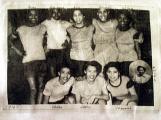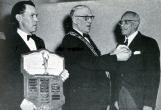14
Reverend Claude Stewart.1930
Hamilton, Ontario, Canada
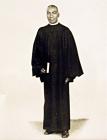 Credits:
Credits:Courtesy of Stewart Memorial Church
15
In 1937, St. Paul's AME Church severed ties with the AME body in the United States and became non-denominational. Its name was changed to Stewart Memorial in honour of Reverend Claude Stewart.17
Jessie Beattie's biography speaks much of his quiet dignity and humanity, and of the very high regard in which Reverend Holland was held by virtually everyone in Hamilton who knew the man. However, her book does not cover some of the important inroads the Hollands made in civil rights. According to Wilma Morrison, respected leader in the heritage community of Niagara Falls, John Holland took a number of Black men down to Stelco and other steel factories in late 1939-early 40 and single-handedly got them work. He insisted that they be hired at a time when these companies were not hiring Blacks. "But this was the kind of man he was," insists Wilma. "He would take on any task at all and just make it seem so easy." Of course, his action bore fruit because "the group were hired and for the most part most of them retired from the steel company."18
Many Hamilton companies not only refused to hire African Canadians but also refused their business in certain theatres, hotels and restaurants. In the late 40s, Wilma recalls how the youth group of the church, led my Oliver Holland, held sit-ins in different restaurants to combat segregated service in some of the restaurants in Hamilton. When confronted with an entire group of African Canadian young people, these places generally caved to the pressure without incident. Thereafter, there were no reported incidents of lack of service to Black people, and the youth would test these restaurants every so often to make sure. However, the Alexandra skating rink, notorious for barring Black people on its premises, would not go down without a fight.As Wilma remembers it:
"We decided we would book [the skating rink]. Oliver Holland, who was Reverend Holland's son, booked it in the young people's names.… We decided that we would all meet at the church and we would go as a group together, and we arrived at the door and the poor doorman had a fit. 'Oh,' he said, 'I think there's been some mistake,' and Oliver said, 'No, there hasn't been any mistake,' - Oliver was a lawyer - and he said, 'No, we booked for the young people's department and then we told him we would be here at 7 o'clock.' 'Oh,' he said, 'I'll have to call my boss.' So he called his boss and she said, 'Don't let them in.' So he came back to us and said that the boss had said that we were not to be allowed in. So, I think they thought that we would just get up and go home, but we didn't. We stayed there, and every time someone opened the door to come in skating, we said, 'Sorry, we're closed.' And so they lost the business for that evening."
Eventually, the Alexandra came to its senses and opened its doors to Blacks. However, these incidents have gone undocumented in our history books.
21
Vince Bryant, postal supervisor, Stewart Memorial trustee, and the ‘Dean of Football'.1980
Hamilton, Ontario, Canada
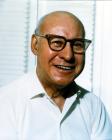
23
John Holland was eventually given the highest honour of a Hamilton citizen by being named Man of the Year for 1953. Wilma Morrison acknowledged that "we [in the Black community] were as proud as proud could be of him."His greatest power was that he was somehow able to win over both the CEOs of the largest companies in Canada and the poorest people he came across through the sheer force of his grace, personality and determination. Reverend Norman Rawson once wrote that John Holland made you forget the Black-white divide: "One never thought of it in his presence and I have often tried to analyze why it was. It wasn't because he ever dodged it, or played it down. He was proud of his race, proud of his ancestry, proud of his humble beginnings…"
24
Brother William Holland and John, wearing Award Medal.January, 1954
Hamilton, Ontario, Canada
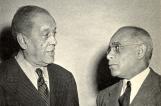 Credits:
Credits:Courtesy of Hamilton Spectator
25
Most people assert that he genuinely cared about and was interested in all people. As Joe Rhodes put it,"Unfortunately, Stewart Memorial at times overlooked the poor Blacks that were struggling, because they didn't attend the church, and because they didn't attend the church, the elders of the church kind of looked down on them - which was sad. But Reverend Holland, on the other hand, … would come into the Black community and actually come out and see people and speak with them, so that influence was always there, and that's always a tremendous influence…. I really enjoyed having that brief time that I did have with him, because he died, as you know, in 1954. …
26
Reverend John Christie Holland memorial plaque21 December 2004
Stewart Memorial Church, John St. Hamilton, Ontario, Canada
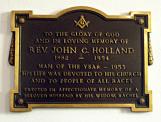
27
Reverend Holland died just three months after receiving the highest accolade any Hamilton resident could receive. Reverend Rawson officiated at his funeral, which took place at Centenary Church in Hamilton."In my day, I have conducted many funerals for people in all walks of life, but that service stands out in my memory. The great Church was filled to the doors, the humble, the poor, the rich, the socially elite, the politically famous were all there and sorrow was written on every face. We had all lost a beloved friend."


